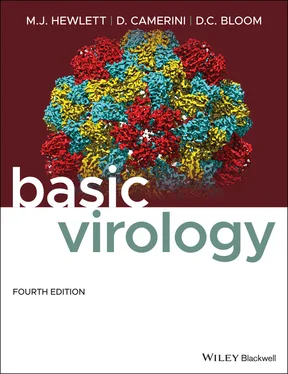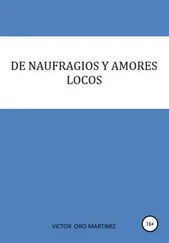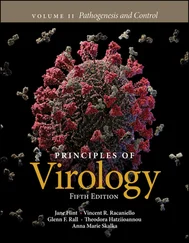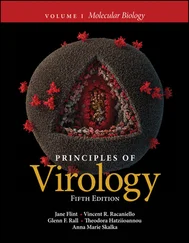1 ...7 8 9 11 12 13 ...33
Examples of the impact of viral disease on human history
There is archeological evidence in Egyptian mummies and medical texts of readily identifiable viral infections, including genital papillomas (warts) and poliomyelitis. There are also somewhat imperfect historical records of viral disease affecting human populations in classical and medieval times. While the recent campaign to eradicate smallpox has been successful and the virus no longer exists in the human population (owing to the effectiveness of vaccines against it, the genetic stability of the virus, and a well‐orchestrated political and social effort to carry out the eradication), the disease periodically wreaked havoc and had profound effects on human history over thousands of years. Smallpox epidemics during the Middle Ages and later in Europe resulted in significant population losses as well as major changes in the economic, religious, political, and social life of individuals. Although the effectiveness of vaccination strategies gradually led to decline of the disease in Europe and North America, smallpox continued to cause massive mortality and disruption in other parts of the world until after World War II. Despite smallpox being eradicated from the environment, the attack of September 11, 2001, on the World Trade Center in New York has led some government officials to be concerned that the high virulence of the virus and its mode of spread might make it an attractive agent for bioterrorism.
Other virus‐mediated epidemics had equally major roles in human history. Much of the social, economic, and political chaos in native populations resulting from European conquests and expansion from the fifteenth through nineteenth centuries was mediated by introduction of infectious viral diseases such as measles. Significant fractions of the indigenous population of the Western Hemisphere died as a result of these diseases.
Potential for major social and political disruption of everyday life continues to this day. As discussed in later chapters of this book, the “Spanish” influenza (H1N1) of 1918–1919 killed tens of millions worldwide and, in conjunction with the effects of World War I, came very close to causing a major disruption of world civilization. Remarkable medical detective work using virus isolated from cadavers of victims of this disease frozen in Alaskan permafrost has led to recovery of the complete genomic sequence of the virus and reconstruction of the virus itself (some of the methods used will be outlined in Part V). While we may never know all the factors that caused it to be so deadly, it is clear that the virus was derived from birds and passed directly to humans. Further, a number of viral proteins have a role in its virulence. Ominously, there is no reason why another strain of influenza could not arise with a similar or more devastating aftermath or sequela– indeed, in the spring/summer of 2005, there was legitimate cause for concern because a new strain of avian influenza (H5N1) had been transmitted to humans. At the present time, human transmission of H5N1 influenza has not been confirmed, but further adaptation of this new virus to humans could lead to it establishing itself as a major killer in the near future.
In April 2009, a new version of H1N1 influenza (now called the 2009 H1N1 flu by the Centers for Disease Control and Prevention [CDC]) was identified in Veracruz, Mexico. Initially H1N1 became epidemic in Mexico, and, as the virus spread rapidly, on June 11, 2009, the World Health Organization declared a pandemic. Because this virus has the same surface markers (H1 and N1) as the infamous “Spanish flu” of nearly 100 years before, there were fears of the same kinds of morbidity and mortality as seen in the early years of the twentieth century. However, this virus turned out to be of no greater lethality than the other seasonal influenza strains currently circulating in the human population. We will discuss more details about this later in this book.
A number of infectious diseases could become established in the general population as a consequence of their becoming drug resistant or introduced as weapons of bioterrorism, or because of human disruption of natural ecosystems. As will be discussed in later chapters, a number of different viruses exhibiting different details of replication and spread could, potentially, be causative agents of such diseases.
Animal and plant pathogens are other potential sources of disruptive viral infections. Sporadic outbreaks of viral disease in domestic animals, such as vesicular stomatitis virus in cattle and avian influenza in chickens, result in significant economic and personal losses. Rabies in wild animal populations in the eastern United States has spread continually during the past half‐century. The presence of this disease poses real threats to domestic animals and, through them occasionally, to humans. An example of an agricultural infection leading to severe economic disruption is the growing spread of the cadang‐cadang viroid in coconut palms of the Philippine Islands and elsewhere in Oceania. The loss of coconut palms has led to serious financial hardship in local populations.
Examples of the evolutionary impact of the virus–host interaction
There is ample genetic evidence that the interaction between viruses and their hosts has a measurable impact on evolution of the host. Viruses provide environmental stresses to which organisms evolve responses. Also, it is possible that the ability of viruses to acquire and move genes between organisms provides a mechanism of gene transfer between lineages.
Development of the immune system, the cellular‐based antiviral interferon (IFN)response, and many of the inflammatory and other responses that multicellular organisms can mount to ward off infection is the result of successful genetic adaptation to infection. In addition, virus infection may provide an important (and as yet underappreciated) basic mechanism to affect the evolutionary process in a direct way.
There is good circumstantial evidence that the specific origin of placental mammals is the result of an ancestral species being infected with an immunosuppressive proto‐retrovirus. It is suggested that this immunosuppression permitted an immunological accommodation in the mother to the development of a genetically distinct individual in the placenta during a prolonged period of gestation!
Two current examples provide very strong evidence for the continued role of viruses in the evolution of animals and plants. Certain parasitic wasps lay their eggs in the caterpillars of other insects. As the wasp larvae develop, they devour the host, leaving the vital parts for last to ensure that the food supply stays fresh! Naturally, the host does not appreciate this attack and mounts an immune defense against the invader – especially at the earliest stages of the wasp's embryonic development. The wasps uninfected with a polydnavirusdo not have a high success rate for their parasitism, and their larvae are often destroyed. The case is different when the same species of wasp is infected with a polydnavirus that is then maintained as a persistent genetic passenger in the ovaries and egg cells of the wasps. The polydnavirus inserted into the caterpillar along with the wasp egg induces a systemic, immunosuppressive infection so that the caterpillar cannot eliminate the embryonic tissue at an early stage of development! The virus maintains itself by persisting in the ovaries of the developing female wasps.
A further example of a virus's role in development of a symbiotic relationship between its host and another organism can be seen in replication of the Chlorella viruses. These viruses are found at concentrations as high as 4 × 10 4infectious units/ml in freshwater throughout the United States, China, and probably elsewhere in the world. Such levels demonstrate that the virus is a very successful pathogen. Despite this success, the viruses can only infect free algae; they cannot infect the same algae when the algae exist semi‐symbiotically with a species of paramecium. Thus, the algae cells that remain within their symbiotes are protected from infection, and it is a good guess that existence of the virus is a strong selective pressure toward establishing or stabilizing the symbiotic relationship.
Читать дальше












